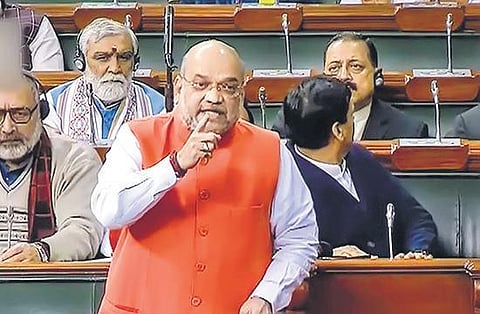

The rubric of politics suggests the winter session was a contest of persuasive arguments on citizenship. It was also a session where MPs learnt some arresting facts about governance. How are Indian citizens doing and how is India faring? A quick review of over 14,000 questions asked by MPs in the Lok Sabha and the Rajya Sabha reveals some startling gaps between promise and performance, between demand and supply, between objectives and outcomes.
In October 2019, UNICEF revealed that in 2018, over 8.82 lakh children died before they reached the age of 5. The government may argue that mortality rates have come down, but it is still at 2,416 deaths per day or 100 deaths per hour. And the maternal mortality rate claims the lives of over 35,000. Life expectancy at birth as per the UN Human Development Report 2019 is better in Nicaragua, Guatemala, Cabo Verde and even Nepal. The magnitude of under-5 deaths in India is enveloped in a complex layer of competing crises and conflicting compulsions.
The front line of the defence against malnutrition and mortality are Anganwadi Centres (AWCs). Umesh Jadhav, BJP MP from Gulbarga, asked about the state of the centres — mind you, this is the contact point for mothers to access critical advice and nutritional care. The government has sanctioned 13.99 lakh AWCs. Of these 13.77 lakh are functional. Of the 13.69 lakh Centres for which information is available, over 1.59 lakh have no drinking water facilities — topping the list is Karnataka, followed by West Bengal and Assam. And over 3.62 lakh have no toilets — UP, Maharashtra and Bihar are worst offenders. The prime cause of under-5 deaths is the quality of neo-natal medical care and issues related to hygiene and the quality of drinking water.
And the contamination of groundwater is a rising concern. Trinamool Congress MP Nusrat Jahan Ruhi asked the government for details of arsenic and other chemicals in groundwater. The Central Ground Water Board has found the presence of fluoride in parts of 370 districts, nitrate in 423 districts, iron in 341 districts, arsenic in 150 districts and lead in 92 districts. Separately, DMK MP S Ramalingam learnt that over 55,000 rural habitations suffer from poor quality of drinking water — the worst-hit states being West Bengal, Rajasthan and Assam.
The slowdown has been and continues to be in the news. The government has chosen to characterise the slowdown as global and cyclical. Be that as it may, what has been the impact on the domestic economy? The pain points range from demand retrenchment to job losses to bad loans in banks and NBFCs. BJP MPs Girish Bapat and Pritam Munde asked about NPAs of banks, and Heena Gavit asked about NPAs of NBFCS. Bank NPAs have gone up from 4.28 per cent in 2015 to 9.08 per cent in 2019, while the NPAs of NBFCs rose from 3.9 per cent to 6.6 per cent in the same period.
Micro Small and Medium Enterprises contribute nearly 30 per cent of the GDP, over 48 per cent of exports, and the bulk of industrial employment. MSMEs have been hurting since demonetisation. Ajay Nishad, BJP MP, asked the government about the impact of the slowdown on MSMEs The RBI, the government revealed, had identified 142,275 MSME accounts as stressed and referred them for ‘corrective action’.
News of the losses of Air India always captures headlines. How are the other PSUs doing? Sadhashiv Lokhande of Shiv Sena and Ranjeeta Koli of the BJP asked the pertinent question. Not too well, as per the government. For three years running, 52 public enterprises have been earning less than their expenditure — that is clocking losses. Cumulatively, between 2015 and 2018, these 52 enterprises have lost Rs 75,932 crore — that is, nearly Rs 3 crore an hour across three years.
The severe slowdown in the economy has naturally triggered many questions about the rising level of unemployment and employment opportunities. Given that private-sector job creation is asymmetric across India, government jobs are critical. Shardaben Patel, BJP MP, asked about the number of vacancies in the Central government. The answer is shocking: of the 38.02 lakh sanctioned posts, over 6.83 lakh posts are vacant.
The challenge of doubling farmer income by 2022 demands investment — in infrastructure and in human talent for research. Harnath Singh Yadav, BJP MP in the Rajya Sabha, asked about scientist posts at the Indian Council for Agricultural Research. The government informed Parliament that of the 6,546 posts, 1,453 posts — that is one in five posts — were vacant.
The phenomenon of vacant posts afflicts states too. The HRD Ministry informed BJP MP from Raichur, Raja A Naik, that of the 9.14 lakh secondary and higher secondary teachers’ posts in schools, over 2.13 lakh posts were vacant. Similarly, of the 23 lakh posts for police personnel, over 5 lakh were vacant. In the critical health sector, of the 25,743 posts of doctors for rural primary health centres, 8,572 are lying vacant. These are but thin slices, a view of the state of governance from Parliament, of the real crises confronting the political economy, drowned in the decibels and dust of us versus them rhetoric.
Shankkar.aiyar@gmail.com